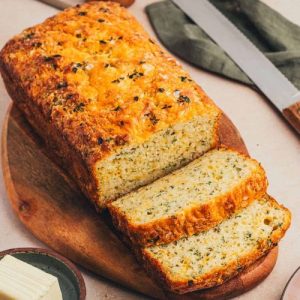
Herb and Cheese Bread
A quick and easy no-yeast bread bursting with sharp cheddar and fragrant fresh herbs. Moist, flavorful, and satisfying, this loaf is perfect for breakfast, brunch, or as a side for any meal. Ready in under an hour, it’s a delicious and comforting addition to your everyday cooking.
Equipment
- 9x5-inch loaf pan
- Large Mixing Bowl
- Medium mixing bowl
- Measuring Cups and Spoons
- Whisk
- Fork or pastry cutter
- spatula
- Wire cooling rack
Ingredients
- 2 cups all-purpose flour
- 1 teaspoon baking powder
- ¾ teaspoon baking soda
- 1 teaspoon salt
- 2 tablespoons granulated sugar
- 6 tablespoons cold unsalted butter diced
- 1½ cups sharp cheddar cheese shredded
- ¼ cup fresh parsley finely chopped
- 1 tablespoon fresh rosemary finely chopped
- 1 tablespoon fresh thyme finely chopped
- 1 cup cold buttermilk
- 2 large eggs
- Flaky sea salt optional, for topping
Instructions
- Prepare Your Baking Equipment: Begin by gathering all the necessary tools a 9×5-inch loaf pan, two mixing bowls, a whisk, measuring cups and spoons, a fork or pastry cutter, and a spatula. Lightly grease your loaf pan with butter or a nonstick baking spray to prevent sticking and ensure an even bake. This step is essential to help your bread release smoothly after baking. Preheat your oven to 350°F (175°C) so it’s ready when your batter is mixed.
- Combine Dry Ingredients: In a large mixing bowl, measure and add 2 cups of all-purpose flour, 1 teaspoon of baking powder, ¾ teaspoon of baking soda, 1 teaspoon of salt, and 2 tablespoons of granulated sugar. Use a whisk to thoroughly blend these dry ingredients until evenly combined. This ensures that the leavening agents and seasonings are distributed evenly, which is critical for consistent texture and flavor throughout the loaf.
- Incorporate Cold Butter: Add 6 tablespoons of cold, diced unsalted butter to the dry mixture. Using your fingers, a fork, or a pastry cutter, work the butter into the flour mixture until it resembles coarse crumbs with pea-sized pieces. This step creates pockets of butter, which melt during baking and give the bread its tender, biscuit-like crumb. Keeping the butter cold is key for achieving this texture.
- Add Cheese and Herbs: Reserve a small handful of 1½ cups shredded sharp cheddar cheese for the topping later. Into the flour and butter mixture, add the remaining cheese along with ¼ cup finely chopped fresh parsley, 1 tablespoon finely chopped rosemary, and 1 tablespoon finely chopped thyme. Gently fold them in with a spatula or spoon until they are evenly distributed. These fresh herbs bring aromatic flavor and a delightful savory note to the bread.
- Mix Wet Ingredients Separately: In a medium mixing bowl, combine 1 cup cold buttermilk and 2 large eggs. Whisk them together until smooth and slightly frothy. The cold buttermilk helps produce a moist texture and adds a subtle tang to the bread, balancing the richness of the cheese.
- Combine Wet and Dry Mixtures: Pour the wet ingredients into the bowl with the dry ingredients. Using a spatula or large spoon, gently fold the mixtures together until no dry streaks remain. The batter should be thick and slightly lumpy. Be careful not to overmix, as excessive stirring can result in dense bread rather than a tender crumb.
- Transfer Batter to Pan: Carefully spoon the batter into the prepared loaf pan, smoothing the surface with a spatula so it’s even. This helps the bread rise uniformly during baking. Sprinkle the reserved cheddar cheese evenly over the top, and optionally add a light pinch of flaky sea salt to enhance flavor and texture.
- Bake the Bread: Place the loaf pan on the center rack of your preheated oven. Bake at 350°F (175°C) for 40–50 minutes. The bread is done when the top is golden brown, and a toothpick or skewer inserted into the center comes out clean or with just a few moist crumbs. Avoid opening the oven door too often during baking to prevent temperature fluctuations.
- Cooling and Removing from Pan: Once baked, remove the bread from the oven and allow it to rest in the pan for about 15 minutes. This resting period helps the bread set and makes removal easier. Then carefully lift the bread out of the pan and transfer it to a wire cooling rack. Allow it to cool slightly before slicing — this preserves the bread’s moist texture and ensures clean slices.
- Serving and Enjoying: Serve this bread warm to enjoy its full flavor and aroma. It pairs wonderfully with soups, salads, or a spread of butter. The sharp cheddar and fresh herbs make it a perfect accompaniment to breakfast, brunch, or dinner. Store any leftover bread in an airtight container at room temperature for up to three days, or freeze for longer storage.
Notes
- Measure precisely: Baking is a science. Use proper measuring cups and spoons, spooning flour into the cup and leveling it off rather than scooping directly from the bag to avoid dense bread.
- Keep butter cold: Cold butter creates flaky pockets in the bread for a tender crumb. Avoid letting butter soften before mixing.
- Fresh herbs matter: Fresh parsley, rosemary, and thyme give the bread vibrant flavor. If using dried herbs, reduce the amounts since they are more concentrated.
- Avoid overmixing: Stir just until ingredients are combined to prevent dense, tough bread.
- Test doneness: Insert a toothpick in the center — it should come out clean or with a few moist crumbs. Avoid underbaking.
- Serve warm: Bread tastes best when served warm. Cool slightly before slicing but enjoy fresh from the oven for the best experience.